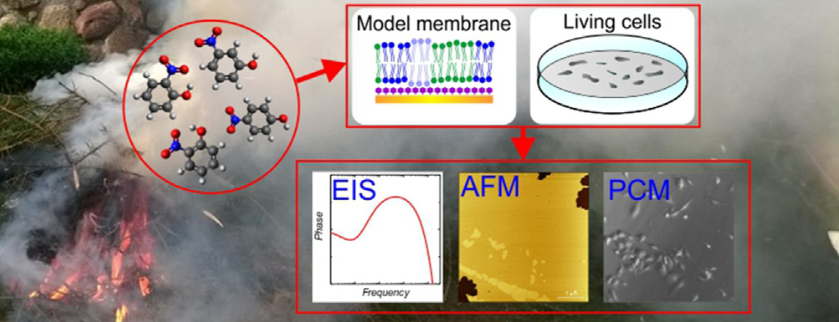Toxicity of selected airborne nitrophenols on eukaryotic cell membrane models
Majewska, M., Khan, F., Pieta, I. S., Wróblewska, A., Szmigielski, R., Pieta, P.
Chemosphere
Abstract
 Nitroaromatics belong to the group of toxic components of aerosol particles and atmospheric hydrometeors that enter the atmosphere through biomass burning and fuel combustion. In the present work, we report on the cytotoxic effects of a 2-, 3- and 4-nitrophenol mixture on a model eukaryotic-like cell membrane and compared it with in vitro cellular models BEAS-2B (immortalized bronchial epithelial cells) and A549 (cancerous alveolar epithelial cells). A selected model biomembrane comprised of DMPC (1,2-dimyristoyl-sn-glycero-3-phosphocholine), DPPC (1,2-dipalmitoyl-sn-glycero-3-phosphocholine) and POPC (1-palmitoyl-2-oleoyl-sn-glycero-3-phosphocholine) was studied. The electrochemical-based method, combined with atomic force microscopy (AFM) and phase-contrast microscopy imaging, allowed to get insights into the mechanism of cellular function disruption caused by airborne nitrophenols. The efficacy of the method is supported by the data obtained from in vitro experiments performed on cell models. The nitrophenol mixture exhibited cytotoxic effects at concentrations above 100 μg mL−1, as demonstrated by phase-contrast microscopy in real lung cell lines. Electrochemical impedance spectroscopy (EIS) revealed the formation of membrane defects at a nitrophenol concentration of 200 μg mL−1. AFM imaging confirmed the model membrane disintegration and phospholipids rearrangement in the presence of nitrophenols. These observations indicate that particle-bound nitrophenols induce substantial changes in cell membranes and make them more permeable to aerosol, resulting in major cellular damage in the lungs when inhaled. The study provides initial evidence of cellular membrane damage induced by three important nitrated phenols present in the environment.
Nitroaromatics belong to the group of toxic components of aerosol particles and atmospheric hydrometeors that enter the atmosphere through biomass burning and fuel combustion. In the present work, we report on the cytotoxic effects of a 2-, 3- and 4-nitrophenol mixture on a model eukaryotic-like cell membrane and compared it with in vitro cellular models BEAS-2B (immortalized bronchial epithelial cells) and A549 (cancerous alveolar epithelial cells). A selected model biomembrane comprised of DMPC (1,2-dimyristoyl-sn-glycero-3-phosphocholine), DPPC (1,2-dipalmitoyl-sn-glycero-3-phosphocholine) and POPC (1-palmitoyl-2-oleoyl-sn-glycero-3-phosphocholine) was studied. The electrochemical-based method, combined with atomic force microscopy (AFM) and phase-contrast microscopy imaging, allowed to get insights into the mechanism of cellular function disruption caused by airborne nitrophenols. The efficacy of the method is supported by the data obtained from in vitro experiments performed on cell models. The nitrophenol mixture exhibited cytotoxic effects at concentrations above 100 μg mL−1, as demonstrated by phase-contrast microscopy in real lung cell lines. Electrochemical impedance spectroscopy (EIS) revealed the formation of membrane defects at a nitrophenol concentration of 200 μg mL−1. AFM imaging confirmed the model membrane disintegration and phospholipids rearrangement in the presence of nitrophenols. These observations indicate that particle-bound nitrophenols induce substantial changes in cell membranes and make them more permeable to aerosol, resulting in major cellular damage in the lungs when inhaled. The study provides initial evidence of cellular membrane damage induced by three important nitrated phenols present in the environment.



